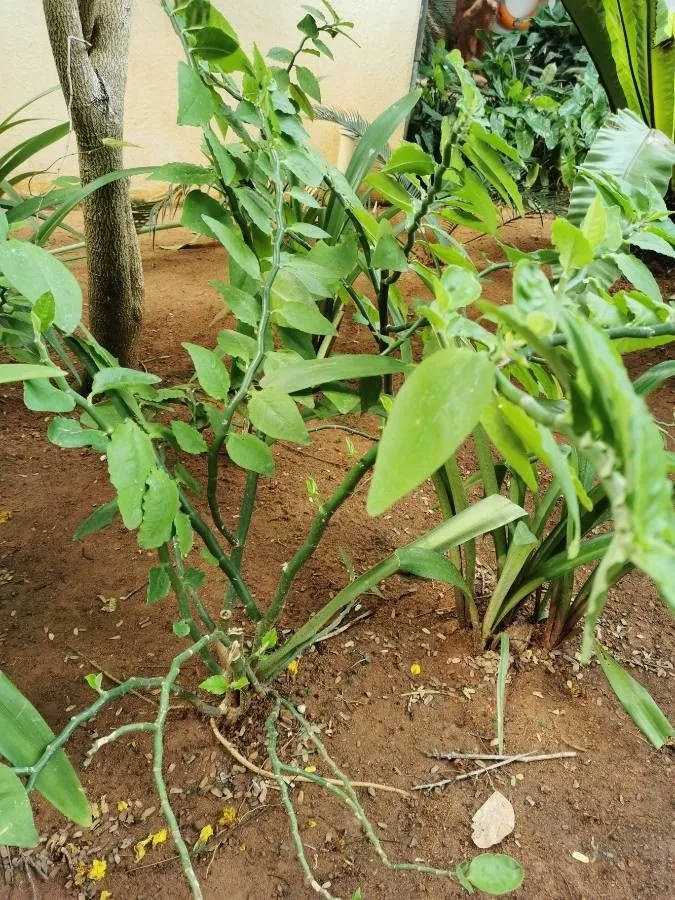
Author: L.
Bibliography: Sp. Pl.: 453 (1753)
Year: 1753
Status: accepted
Rank: species
Genus: Euphorbia
Vegetable: False
Observations: Florida, Mexico to Trop. America
The Slipper-flower, known scientifically as Euphorbia tithymaloides, captures the curiosity of botanists and horticulturists alike. This striking plant belongs to the Euphorbiaceae family, a group renowned for its diverse and often unusual members.
First described in 1753 by the botanist Carl Linnaeus, whose authority on botanical nomenclature is widely respected, Euphorbia tithymaloides has intrigued plant enthusiasts for centuries. It is featured in Linnaeus’s seminal work, “Species Plantarum,” on page 453, marking its official introduction into the botanical canon.
The Slipper-flower exhibits a unique aesthetic that comes from its characteristic slipper-shaped flowers, drawing attention with their whimsical and intricate design. The plant thrives in a variety of environments, showcasing its adaptability and resilience.
Native to a broad range, Euphorbia tithymaloides is found from Florida in the southeastern United States, extending through Mexico and reaching deep into tropical regions of Central and South America. In these regions, it can often be spotted in local flora, contributing to the biodiversity and ecological richness of these habitats.
The plant’s appeal is not just in its visual charm but also in its ecological role. It provides nectar and habitat for a variety of pollinators, playing a crucial part in maintaining the health of tropical ecosystems. Gardeners and landscapers favor the Slipper-flower for its ornamental value and its ability to thrive in warm climates, often using it to add a touch of tropical elegance to gardens and landscapes.
In summary, Euphorbia tithymaloides is more than just a pretty face in the plant world. Its historical significance, ecological contributions, and ornamental beauty make it a cherished species within the Euphorbiaceae family. Whether found in the wilds of Florida or the tropical expanses of Central and South America, the Slipper-flower continues to enchant and sustain.
Eng: japanese-poinsettia, devil’s-backbone, milkbush, redbird flower, redbird-cactus, redbird-flower, slipper-flower, slipperplant, lady’s slipper
Swe: skobuske
En: Slipper-flower, Slipperplant, Milkbush, Japanese-poinsettia, Devil’s-backbone, Redbird-cactus, Redbird-flower, Slipper flower, Redbird flower, Lady’s Slipper, Devil’s backbone
Bn: রাং চিতা
Zh: 紅雀珊瑚, 红雀珊珊
Fi: Mehipolvi
Id: Sig-sag
Ml: തത്തമ്മച്ചെടി
Pa: ਯੁਫ਼ੋਰਬੀਆ ਟਿਥੀਮਾਲਿਓਡਦਸ
Fa: یوفوربیا تیتیمالویدس
Ru: Педилантус титималоидный
Sv: Skobuske
To: Matavivi
Zh-hant: 紅雀珊珊
Vi: Cây thuốc giấu
© copyright of the Board of Trustees of the Royal Botanic Gardens, Kew.
© copyright of the Board of Trustees of the Royal Botanic Gardens, Kew.
© copyright of the Board of Trustees of the Royal Botanic Gardens, Kew.
Taken Jan 3, 2020 by Mazin Mazin (cc-by-sa)
Taken Apr 23, 2015 by Nelson Zamora Villalobos (cc-by-nc)
Taken Aug 13, 2022 by Ahmed Ismail (cc-by-sa)
Taken Feb 5, 2020 by claire Felloni (cc-by-sa)
Taken Jan 1, 1900 by EOL − Carrington, S. (cc-by-nc-sa)
Taken Apr 1, 2021 by Estelle Lefrancois (cc-by-sa)
Taken Aug 19, 2021 by Таццяна Таццяна (cc-by-sa)
Taken May 17, 2022 by Naushad BM (cc-by-sa)
Taken Jun 21, 2022 by Trap Hers (cc-by-sa)
Taken Oct 24, 2021 by Sacoman Andressa (cc-by-sa)
Taken Jun 21, 2022 by Trap Hers (cc-by-sa)
Taken Jul 9, 2021 by Vernise Mc Donald (cc-by-sa)
Taken Nov 22, 2021 by Okim (cc-by-sa)
Taken Nov 5, 2020 by Lisa Ani (cc-by-sa)
Taken Oct 2, 2021 by Polina Arefieva (cc-by-sa)
Taken Oct 6, 2021 by Carrasco Siria (cc-by-sa)
Taken May 31, 2020 by Ricobom Neide (cc-by-sa)
Taken Mar 5, 2020 by Gasser Nadia (cc-by-sa)
Taken Sep 29, 2021 by Chris Thodey (cc-by-sa)
Taken Dec 24, 2019 by Vijigiri Dr Vijigiri Dinesh (cc-by-sa)
Taken Dec 2, 2022 by Kevin (cc-by-sa)
Taken Nov 16, 2022 by florent Palach (cc-by-sa)
Taken Oct 26, 2021 by Simoes Gabriela (cc-by-sa)
Taken Jan 11, 2021 by Arvind Kulkarni (cc-by-sa)
Taken Jun 7, 2020 by Hendra Wijaya (cc-by-sa)
Taken May 18, 2019 by Prakash Rudraraju (cc-by-sa)
Taken Feb 15, 2017 by Photoflora – Benoit BOCK (©)
Taken Dec 27, 2019 by Ben Ostrowsky (cc-by-sa)
Taken Oct 3, 2022 by Norman Reyes (cc-by-sa)
Taken Feb 21, 2022 by Manuel Aceves (cc-by-sa)
Family: Myrtaceae Author: (F.Muell.) K.D.Hill & L.A.S.Johnson Bibliography: Telopea 6: 402 (1995) Year: 1995 Status:…
Family: Rubiaceae Author: Pierre ex A.Froehner Bibliography: Notizbl. Bot. Gart. Berlin-Dahlem 1: 237 (1897) Year:…
Family: Sapindaceae Author: Koidz. Bibliography: J. Coll. Sci. Imp. Univ. Tokyo 32(1): 38 (1911) Year:…
Family: Asteraceae Author: A.Gray Bibliography: Pacif. Railr. Rep.: 107 (1857) Year: 1857 Status: accepted Rank:…
Family: Fabaceae Author: Medik. Bibliography: Vorles. Churpfälz. Phys.-Ökon. Ges. 2: 398 (1787) Year: 1787 Status:…
Family: Aspleniaceae Author: (Cav.) Alston Bibliography: Bull. Misc. Inform. Kew 1932: 309 (1932) Year: 1932…